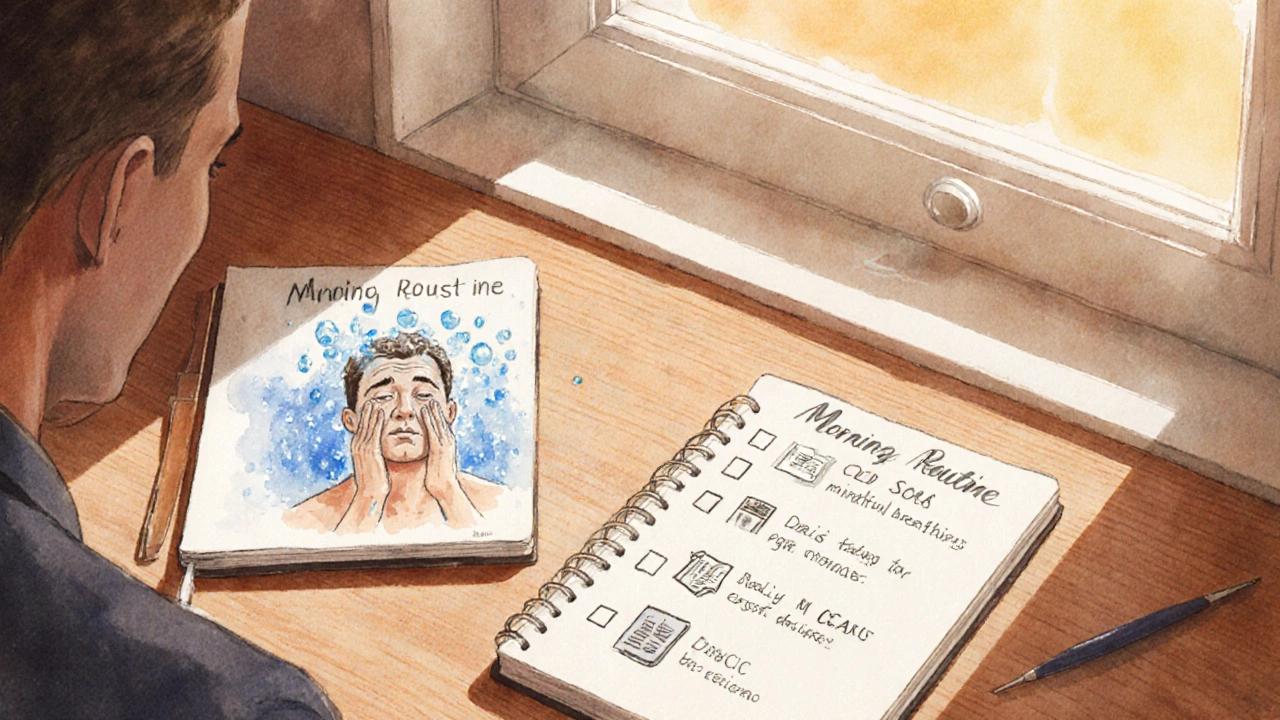Personality Development Habit Tracker
Daily Personality Development Habits
Track your progress on the 5 key habits from the article. Consistency is the key to developing a strong personal presence.
Cold-Water Face Splash
2 minutes - Reinforces discipline
Mindful Breathing
5 minutes - Enhances emotional intelligence
Review Daily Goals
10 minutes - Builds confidence
Read a Classic Essay
15 minutes - Deepens conversation skills
Grooming Routine
10 minutes - Enhances personal style
Your Personal Presence Progress
Track your consistency over time and watch your personal presence grow.
When you think about a modern gentleman, the first image that springs to mind isn’t just a well‑tailored suit or a polished shoe. It’s the way he carries himself, the ease with which he engages a conversation, and the subtle confidence that makes a room feel a little brighter. Below is a practical roadmap that turns the abstract idea of "gaining personality" into concrete habits you can adopt today.
Understanding Personality
Personality is the unique blend of thoughts, habits, and behaviours that shape how others perceive you. It reflects your inner values, emotional patterns and outward presentation. For a gentleman, personality isn’t a performance; it’s an authentic expression of character that aligns with timeless values such as integrity, curiosity, and composure.
Foundations: Confidence and Emotional Intelligence
Confidence is the quiet assurance that you can meet life’s challenges without over‑reacting. Build it by setting small, achievable goals-whether that’s mastering a new tie knot or delivering a brief presentation at work. Each win adds a measurable boost to your self‑esteem.
Emotional Intelligence (EI) gives you the map to navigate feelings-both yours and others'. Practice EI by pausing before responding in heated moments, noting the emotions at play, and choosing a measured reply. Over time, you’ll notice a calmer demeanor that others instinctively trust.
External Expressions: Body Language, Grooming, and Personal Style
Body Language speaks louder than words. Adopt three simple habits: keep shoulders relaxed, maintain eye contact for 4‑6 seconds, and mirror the posture of the person you’re speaking with. These cues convey openness and confidence without a single utterance.
Grooming is the silent contract you make with the world. A clean haircut, well‑moisturised skin, and a subtle fragrance signal respect for yourself and those around you. Schedule a weekly grooming audit: trim facial hair, inspect nails, and replenish skincare supplies.
Personal Style is the visual extension of character. Invest in classic pieces-navy blazer, crisp white shirt, leather Oxford shoes-and let fit be the priority. Fit, colour coordination, and texture add depth without shouting.
Communication Mastery: Conversation, Storytelling, and Listening
Communication Skills are the tools that turn thoughts into influence. Follow a three‑step framework: 1) State the purpose clearly, 2) Provide supporting details, 3) Invite feedback. This structure works in meetings, networking events, and casual conversations.
Storytelling transforms data into memorable experiences. Use the classic arc-setup, conflict, resolution-to share professional anecdotes. A well‑told story not only illustrates competence but also reveals empathy.
Active listening is the counterpart to storytelling. Nod, paraphrase, and ask open‑ended questions to demonstrate genuine interest. This habit builds rapport faster than any polished line.

Social Dynamics: Networking and Presence
Networking is less about collecting cards and more about nurturing mutually beneficial relationships. Target quality over quantity: schedule a monthly coffee with a peer, attend a niche industry meetup, and follow up with a handwritten note. Consistency turns acquaintances into allies.
Personal Presence is the sum of all the habits above, amplified by the energy you emit. To test your presence, observe the reaction of a room when you enter-are heads turning, do people greet you, do conversations naturally gravitate toward you? Adjust by refining any of the earlier pillars.
Building Resilience: The Backbone of a Strong Personality
Resilience equips you to bounce back from setbacks without losing composure. Adopt the "5‑Minute Reset" technique: after a failure, spend five minutes breathing, noting three things you learned, and planning a single corrective action. This habit rewires the brain to view challenges as growth opportunities.
Daily Routine Checklist
| Practice | Duration | Personality Trait Reinforced |
|---|---|---|
| Cold‑water face splash | 2 minutes | Discipline |
| Mindful breathing | 5 minutes | Emotional Intelligence |
| Review daily goals | 10 minutes | Confidence |
| Read a classic essay | 15 minutes | Depth of Conversation |
| Grooming routine | 10 minutes | Personal Style |

Common Pitfalls and How to Avoid Them
- Over‑polishing: Trying to be perfect can appear artificial. Embrace small imperfections-they add authenticity.
- Neglecting health: Physical fatigue erodes confidence and poise. Prioritise sleep, nutrition, and moderate exercise.
- One‑size‑fits‑all networking: Attend events that align with your interests; forced attendance leads to shallow connections.
- Ignoring feedback: Dismissed criticism stalls growth. Seek trusted opinions and act on constructive points.
Next Steps
Choose three habits from the checklist above and integrate them into your routine for the next 30 days. Record observations-how does your posture improve? Do conversations feel more natural? At the end of the month, reassess and add two new practices. Incremental progress compounds into a noticeable, lasting personality.
Frequently Asked Questions
Can personality really be changed, or is it fixed at birth?
Personality is a mix of genetic predisposition and life experiences. While core temperament offers a baseline, deliberate habits-like those described here-can reshape behaviours and how you’re perceived.
How long does it take to see a noticeable shift?
Consistent effort over 30‑60 days yields the first visible changes. Confidence and body language improve quickly; deeper traits such as emotional intelligence develop over several months.
Do I need a mentor or coach?
A mentor accelerates growth by offering perspective and accountability, but self‑directed practice works well if you track progress and stay disciplined.
What role does style play in personality?
Style is the visual extension of inner values. A well‑chosen wardrobe reinforces confidence and signals respect, which in turn shapes how others interact with you.
How can I stay motivated during setbacks?
Apply the “5‑Minute Reset” technique, revisit past successes, and remind yourself that resilience is built through adversity.
personality development is not a single event but a series of intentional choices. By aligning confidence, emotional intelligence, grooming, and communication, you craft a refined presence that resonates with the world while staying true to your core values.

